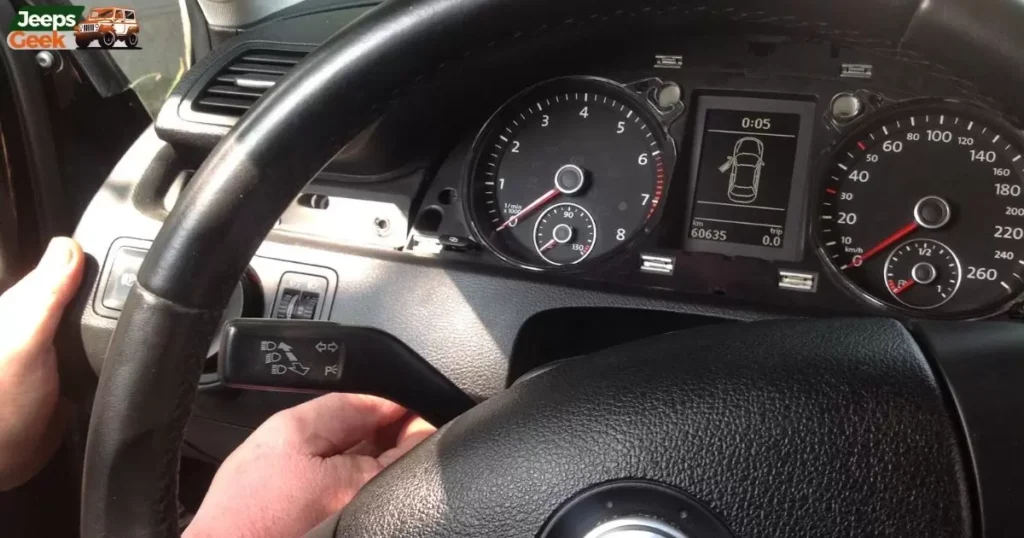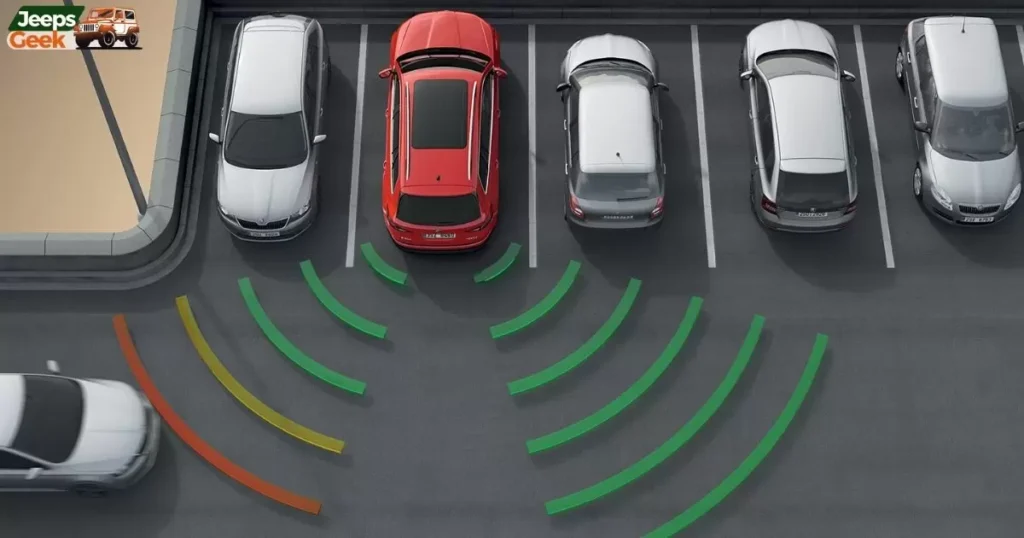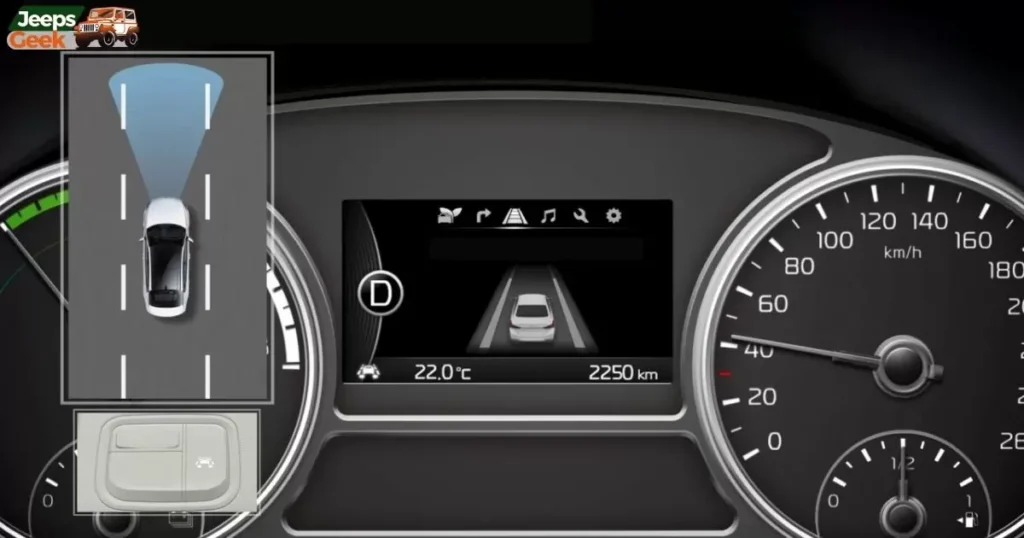The park assist system is really important nowadays. It’s a complex system made up of sensors, cameras, and a module. Sometimes, it doesn’t work properly. When this happens, your Jeep’s display shows an error message saying Service park assist system.
When you see this message, it could mean a few things are wrong. Your sensors might be broken, dirty, or covered by something, or there could be issues with the systems connected to the park assist.
It might also be due to electrical problems or a faulty park assist module or electronic shift module. This issue commonly occurs with Jeep Grand Cherokee and Jeep Commander drivers.
To fix this problem, you need to figure out what’s causing it. Once you find the exact reason, you can try to solve it. Here’s what you can do:
First, check the connectors and sensors. If needed, replace the sensors and then the module.
What Does the Service Park Assist System Mean?
When you’re driving your Jeep and suddenly spot the Service Park Assist System warning light, it’s your vehicle telling you something needs attention. The Park Assist System is a set of sensors and technology designed to help you park safely.
This system detects obstacles around your car and alerts you to potential collisions. When the warning light appears, it means the system has detected an issue that needs fixing.
The Park Assist system in your Jeep uses special cameras and sensors to notice things behind your car. It tells you if you’re getting too close to them to help you avoid hitting them and damaging your car.
If something is stopping the Park Assist system from working right, your Jeep will show a message that says Service Park Assist System. When this happens, and you try to back up, your display will show an error message. There will also be a sound that happens once every time you start your car. The error message will stay on the screen as long as you’re reversing.
If the sensors get dirty, they might not work properly, and you could see a message saying Clean Park Assist Sensors. Also, if something like a trailer is blocking the sensors and cameras, you might see a message that says Parking System Blocked.
read also: Jeep 6-Speed Manual Transmission Problems
Service Park Assist System: Why does it come on?

Jeeps have a park assist system to help you see areas that are hard to notice while parking. This system helps prevent your car from getting damaged or scratched. If the system finds a problem, it stops working temporarily.
Here are some reasons why the system might stop working:
- Dirty sensors: If the sensors that help the system detect things get dirty, they might not work properly.
- Weather conditions: Sometimes, extreme weather like heavy rain or snow can affect how the system works.
- Electrical issues: Problems with the car’s electrical system could also make the park assist system stop working.
It’s important to know these reasons so you don’t worry if you see a message about the service park assist system in your Jeep.
One or More Dirty/Faulty Sensors
The Park Assist System relies on sensors placed around your Jeep. Sometimes, these sensors can get dirty or damaged, causing inaccurate readings or system failure.
Cleaning these sensors can often resolve the issue. Gently wipe them with a soft, clean cloth to remove any dirt or debris. If cleaning doesn’t work, a faulty sensor might need replacement.
Sensors are really important for the park assist system in your car. They tell the system where your car is with things around it.
Your car has different types of sensors, like radar and proximity sensors. If these sensors aren’t working properly or aren’t sending signals, you might see an error message about the park assist system in your Jeep.
There are a few reasons why the sensors might not be working:
- Sometimes the sensors get too dirty, maybe from mud or insects, and that can mess up their signals. Even after cleaning your car, some leftover dirt or debris can stick around the sensors and cause problems.
- If water or moisture gets inside the sensors, perhaps because you drove through water or mud, it can make the sensors stop working correctly.
- The sensors might get damaged or there could be a problem with the wiring. Even a small accident or bump can break the sensors because they’re delicate. If this happens, you’ll need to replace them.
- Sometimes people add things like big fenders or accessories that block the sensors’ path. Attaching a trailer can also cause the system to stop working properly.
read also: Is SiriusXM Guardian Worth It?
Problems with One or More Systems Related to Park Assist
Sometimes, issues with other systems connected to the Park Assist System can trigger the warning light. This could include problems with the vehicle’s electrical system, battery issues, or software malfunctions. Checking these related systems can help pinpoint the root cause of the warning light.
The park assist system in your car uses different parts like brakes, steering, engine, and gears to help you park. It tells these parts what to do so you can park easily. But if any of these parts has a problem, the park assist system stops working.
Luckily, your car can notice these problems before the park assist system does. If you’re used to driving, you might feel when something’s wrong. If you’re not sure, you can use a scanner to check for error codes that show what’s going
Electrical Issues
Electrical problems can be another reason behind the Service Park Assist System warning. Faulty wiring, corroded connections, or power supply issues can disrupt the proper functioning of the Park Assist System. A thorough inspection by a qualified mechanic can identify and fix these electrical glitches.
When you’re driving in reverse, different parts of the car like sensors and the park assist system talk to a main control unit. If something goes wrong with the electrical system, such as a loose wire, a short circuit, or a blown fuse, these systems might not work properly.
All these systems in your car rely on the battery. If the battery doesn’t work right, it can cause a lot of problems for your car. Sometimes, if there’s something wrong with the connections, it can even drain the battery when the car is turned off.
The part of the car that helps with parking has connectors low down. That means water or dirt can easily get inside them. This can make the connections corrode and not work well.
Damaged Wiring
Wiring that’s been damaged due to wear and tear or external factors can impede the Park Assist System’s functionality. Exposure to extreme temperatures or physical damage can cause wiring issues. Inspecting the wiring and repairing or replacing damaged sections can often resolve this problem.
There might be a problem with the wires or connections. They could be broken or not connected well. If the connections are loose, it might stop the system from working right. If the parts that help you park don’t have power, then there’s an issue.
Blown Fuses
Fuses act as protective components for various electrical systems in your Jeep. A blown fuse can cause the Park Assist System to malfunction. Replacing a blown fuse might be a simple fix, but it’s essential to investigate why the fuse blew to prevent future issues.
Fuses stop parts from getting damaged if something goes wrong. If a fuse breaks, it can create problems. For example, it might make the park assist system act strangely.
Park Assist Module is Not Working
If none of the above issues seem to be the cause, the problem might lie with the Park Assist Module itself. This module controls the Park Assist System and may require professional diagnosis or replacement.
These days, Jeeps come with a park assist feature. This feature is managed by a special module. This module controls sensors by sending power to them and getting signals back. It figures out how far things are from the car. Think of it as the brain of the whole system.
Sometimes, this module might have a problem and stop working correctly. When this happens, the main computer in the Jeep turns off the park assist system. You’ll see a message saying Service park assist system. This lets you know that something’s not working as it should.
Faulty Electronic Shift Module
The part of your car that helps you shift gears, called the electronic shift module (ESM), can stop working correctly. It has a small board inside that might not work right sometimes. When this happens, all the other parts connected to it might start acting strangely. This is because lots of systems in the car receive a signal from the ESM when you shift gears or move in reverse. So, if there’s a problem with your ESM, it might cause an error message to show up for the park assist system in your car, which might seem surprising.
read also: Troubleshooting Jeep Backup Camera Black Screen
Feature Scope:
1. Ultrasonic Sensors:
- Utilizes sound waves to detect obstacles around the vehicle.
- Provides accurate distance measurements between the vehicle and obstacles.
2. Rearview Camera Systems:
- Offers a clear view of the vehicle’s rear surroundings on the dashboard display.
- Helps in visualizing obstacles and aids in precise parking maneuvers.
3. Automatic Parking Assistance:
- Automated steering control assists in maneuvering the vehicle into parking spaces.
- Automated braking systems help prevent collisions by stopping the vehicle when obstacles are detected.
4. Audible and Visual Alerts:
- Audible beeps or alerts notify the driver of the proximity to obstacles during parking.
- Visual displays on the dashboard or infotainment screen provide real-time feedback about nearby obstacles.
5. Multi-Point Detection:
- Sensors placed strategically around the vehicle offer comprehensive coverage.
- Detects obstacles from multiple angles, reducing blind spots and increasing accuracy.
6. Adaptive Systems:
- Adaptive steering assists in parking by adjusting the vehicle’s steering responsiveness.
- Adaptive distance control modifies sensitivity based on the proximity of surrounding objects.
7. User Interface and Controls:
- Intuitive controls on the vehicle’s display allow for customized Park Assist settings.
- Voice commands enable hands-free operation and control of Park Assist features.
8. Self-Parking Features:
- Semi-autonomous or fully autonomous parking capabilities without significant driver input.
- It can guide the vehicle into parking spaces automatically, reducing the driver’s effort.
9. Environmental Adaptability:
- Systems designed to function optimally in various weather conditions and terrains.
- Ensures consistent performance in rain, snow, fog, etc.
10. Smart Connectivity:
- Integration with smart city infrastructure for real-time parking space availability.
- Communicates with parking facilities or other vehicles for enhanced parking assistance.
Read also: Service Passive Entry System: 7 Tips To Fix The Warning
How Do You Service Park Assist System?

The Service Park Assist System warning in your Jeep can cause concern. Still, there are several steps you can take to address the issue and potentially resolve it without extensive mechanical expertise.
1. Clean the Park Assist System Sensors
Often, the warning light may indicate dirty sensors. Gently clean the sensors with a soft cloth to remove dirt and debris that might obstruct their functionality. A thorough cleaning can sometimes restore proper sensor operation and eliminate the warning light.
If you see an error message, first check if the sensors at the back of the car are dirty. If they are, clean them.
Some cars can tell you which sensor isn’t working if you try to fix the problem. It’s a good idea to clean all the sensors now and then.
To clean the sensors, use water, carwash soap, and a soft cloth. Please don’t use anything that might scratch them. Be gentle and don’t press too hard on the sensors.
If the sensors are covered in mud or snow, be extra careful when cleaning them to avoid causing damage.
Make sure to clean the sensors regularly. If you don’t, the system might not detect objects behind your car accurately or might give incorrect signals about something being behind you.
2. Replace Your Park Assist System Sensors
If cleaning doesn’t solve the problem, your sensors might be damaged or faulty. Replacing these sensors may be necessary to ensure the Park Assist System functions correctly. Consult your Jeep’s manual or a professional mechanic for guidance on sensor replacement.
Start by separating the sensors and cleaning them. If they’re not too damaged, you can keep using them. But if you find out that your park assist sensors aren’t working properly, then change them. Doing that should fix the problem.
3. Check Your Batteries, Fuses, and Wiring
Electrical issues can trigger the Service Park Assist System warning. Check your vehicle’s batteries, fuses, and wiring for any signs of damage, corrosion, or loose connections. Replace blown fuses or damaged wiring to ensure proper electrical flow.
Test your batteries to make sure they are working properly. Then, inspect to see if there is a fuse that has stopped working. Make sure the batteries are in the right place.
Also, ensure that all the metal parts and plugs are firmly connected. Use a tool to check if the wires connected to the ground work properly.
Look at the connectors that send signals. Make sure they are not loose and there is no rust. Put a special type of grease on them that helps with electricity. If you often drive through water and mud, use a lot of this grease on the metal connections under the car. This might take some time, but it’s a good thing to do.
4. Replace the Park Assist Module
If the warning persists, the problem could lie within the Park Assist Module itself. This component controls the entire Park Assist System and may need to be replaced if it’s malfunctioning. Seek assistance from a qualified mechanic to diagnose and replace the module if necessary.
If the part that helps you park your car isn’t working, you should get a new one. That should fix the problem. But before you change it, try resetting the system to see if that helps.
The part is located under the middle seat on the left side in the back of the car. You can switch it out by folding down the second-row seat without needing any tools.
5. Reset the Park Assist System
Sometimes, resetting the Park Assist System can resolve minor issues. Consult your Jeep’s manual for instructions on how to reset the system. This simple step might clear the warning light and restore the system’s functionality. When you see an error message for the park assist system in your Jeep, you can fix it by resetting it. There are two ways to do this:
- Disconnect the Battery: First, turn off your car and disconnect the batteries by taking off the cables. Wait for 10-15 minutes, then reconnect the cables. Your Jeep will completely reset, and the park assist system should start working again.
- Use the Parksense Button: Look for a button labeled Parksense under the touch screen in your car. Press and hold this button for about 10-15 seconds while the system is on. You’ll hear a long beep, indicating that the park assist system has been reset. It should work normally now. This method is the easiest way to reset the system.
If the specific problem we’ve discussed persists even after resetting, the error will return. In that case, you’ll need to focus on finding and fixing the exact issue causing the problem.
6. Replace the Electronic Shift Module
In some cases, the Electronic Shift Module can cause the Service Park Assist System warning to appear. If this module is faulty, it might disrupt the overall functioning of the Park Assist System. Replacing it could resolve the issue and eliminate the warning light.
Start by opening up the ESM (a part in a Jeep) and cleaning it thoroughly. If cleaning doesn’t solve the issue, consider replacing the ESM. However, be aware that even with a new ESM, the problem might not completely go away because these modules in Jeeps sometimes have flaws in their design.
You can find more information on fixing warnings about the Passive Entry System and Air Suspension System in your Jeep.
Future Scope
Advanced Sensor Technologies
Future Park Assist Systems might incorporate more advanced sensor technologies like LiDAR (Light Detection and Ranging), radar, or even artificial intelligence-driven cameras. These sensors could offer improved detection capabilities, accurately identifying obstacles in various weather and lighting conditions.
Enhanced Autonomous Parking
As autonomous vehicle technology continues to evolve, Park Assist Systems may become more sophisticated, allowing vehicles to navigate and park in complex and crowded environments autonomously. Advanced algorithms and machine learning could enable vehicles to find parking spots, maneuver, and park without driver intervention.
Integration with Smart Infrastructure
Integration with smart city infrastructure could revolutionize Park Assist Systems. Vehicles could communicate with parking facilities, accessing real-time data on available parking spaces. This integration might streamline the parking process, reducing congestion and optimizing parking space utilization.
Augmented Reality (AR) Assistance
Future Park Assist Systems might incorporate augmented reality features, providing drivers with visual assistance while parking. AR overlays could display virtual guides or markers on the vehicle’s screen, making parking more intuitive and precise.
Predictive Maintenance and Diagnostics
Advancements in vehicle diagnostics and predictive maintenance could enhance Park Assist Systems. Continuous sensor performance monitoring and analysis could predict potential issues before they occur, allowing for proactive maintenance and minimizing unexpected warning lights or system failures.
Enhanced User Experience and Customization

Future systems might offer more customizable settings and user interfaces. Drivers could have greater control over the Park Assist System, tailoring it to their preferences and specific parking needs.
Environmental and Safety Considerations
There might be a focus on environmental sustainability, with Park Assist Systems aiming to reduce vehicle emissions and energy consumption during parking maneuvers. Additionally, safety features could be further enhanced to prevent collisions not only during parking but also while the vehicle is stationary.
Pros and Cons
Here’s a table highlighting the pros and cons of Park Assist Systems in vehicles, including those found in Jeep models, using ticks (✔) for pros and crosses (❌) for cons:
| Pros | Cons |
| ✔ Enhanced Safety: Helps prevent collisions and accidents while parking. | ❌ Dependency on Sensors: Malfunctioning sensors can lead to inaccuracies or system failure. |
| ✔ Ease of Parking: Makes parking in tight spaces easier, reducing driver stress. | ❌ Limited Effectiveness: May not work optimally in all weather or environmental conditions. |
| ✔ Time-Saving: Speeds up the parking process, especially in crowded areas. | ❌ Cost: Installation and repair of Park Assist Systems can be expensive. |
| ✔ Accessibility: Can assist drivers with limited mobility or spatial awareness. | ❌ Potential Distraction: Overreliance on the system might distract drivers from being vigilant. |
| ✔ Technology Advancements: Continual improvements in sensors and software offer better accuracy. | ❌ Maintenance Needs: Requires regular maintenance and cleaning to function optimally. |
| ✔ Resale Value: Equipped vehicles might have higher resale value due to added features. | ❌ Complexity: Some drivers may find the technology complex or difficult to understand. |
Final Words
Your Jeep’s park assist system is really helpful. It helps you park easily and stops small accidents. But remember, don’t rely on it completely. It’s important to look where you’re going yourself.
To make sure the park assist keeps working well, get it checked regularly and keep the sensors clean. If you see an error message about the park assist system in your Jeep, try to fix the problem yourself.

Meet James Wilson, the driving force behind “Jeeps Geek.” As a dedicated Jeep enthusiast, I’ve navigated the trails, tinkered under the hood, and conquered every off-road challenge. Join me on the Jeeping journey where I share insights, troubleshoot issues, and celebrate the thrill of the open road.













